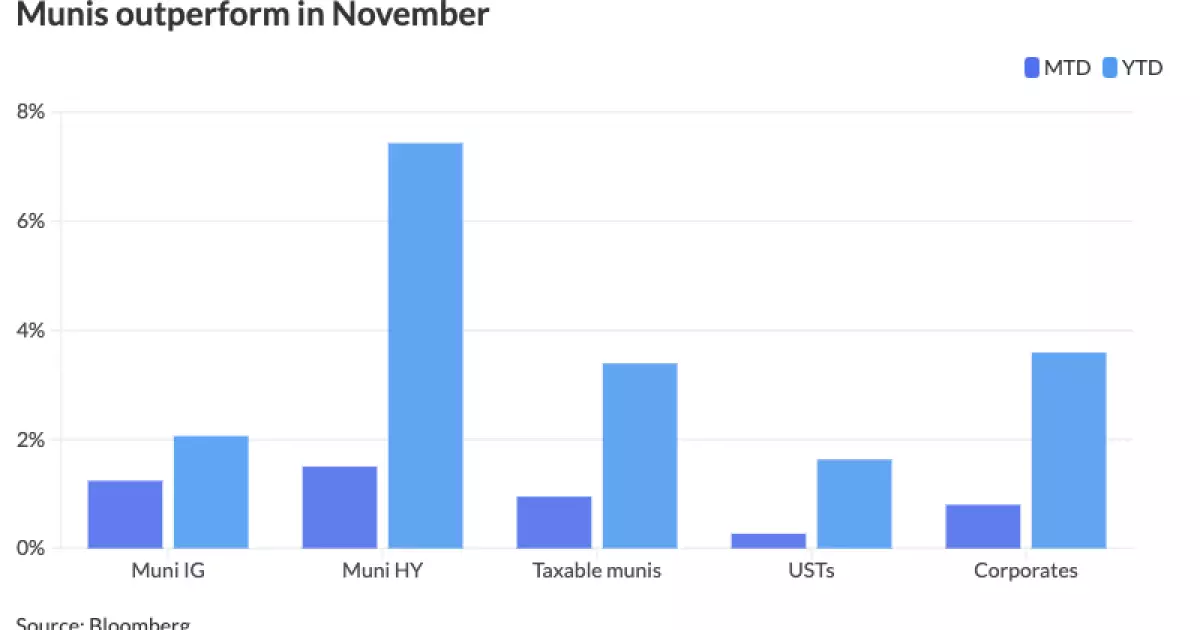In a notable trading session, municipal bonds showcased resilience by outperforming minor declines seen in U.S. Treasuries, signaling investor confidence amid a backdrop of cautious optimism in the financial markets. This market behavior coincided with a historical performance for equities, where both the Dow Jones Industrial Average and the S&P 500 reached new heights. Much of the day’s movements were underpinned by insights from the Federal Open Market Committee (FOMC) minutes, which reflected a deliberate and cautious approach by the Federal Reserve regarding future monetary policy adjustments.
As highlighted by BMO’s Senior Economist Priscilla Thiagamoorthy, the FOMC minutes from the recent meeting indicated a strategic shift towards maintaining a neutral monetary policy stance. The phrase “no hurry” to reduce interest rates, as emphasized by Federal Reserve Chair Jerome Powell, reinforced the intention to move thoughtfully rather than hastily. Economists and investors, alike, interpreted this as an indication that the Federal Reserve would proceed with caution as the economy continues to evolve.
Market Dynamics: Yields and Demand
The municipal bond market exhibited strength, with triple-A rated yield curves reflecting a decrease of up to five basis points. Conversely, U.S. Treasuries experienced losses of varying degrees. Matt Fabian, a partner at Municipal Market Analytics, pointed to the improving distribution of municipals to retail investors as a key driver for this trend. Investors are clearly navigating towards an environment where yields are more appealing, prompting increased buying activity, especially as the year-end approaches alongside a holiday calendar characterized by minimal issuance.
As the fixed income sector ended with a modest rally, demand for liquid municipal bonds amidst the primary market was robust. This trend suggests a broader interest from retail investors, demonstrating a shift towards safer investment choices in the face of geopolitical and economic uncertainties reflected in the bond markets. Observations pointed to a potential softening of U.S. Treasuries in December, which may allow municipal bonds to outperform them.
Performance Metrics: Analyzing Returns
The performance indicators reveal that municipals are returning 1.24% for November and 2.06% year-to-date, according to the Bloomberg Municipal Index. High-yield municipal bonds are notably performing even better, posting gains of 1.50% for the month and 7.43% year-to-date. Comparatively, USTs generated modest returns of 0.27% for November and 1.63% cumulatively for the year. In the context of corporate bonds, these instruments have shown respectable returns as well, suggesting that investor sentiment is more favorable towards fixed income securities.
The ratios comparing municipal yields to U.S. Treasury securities, namely the two-year at 61% and the 10-year at 66%, point to the relative attractiveness of municipal bonds, reflecting their secure stature within the broader market. This has prompted analysts to observe trends in trading patterns; longer-duration structures are attracting significant interest, while yields in shorter maturities displayed less volatility amid market fluctuations.
Despite a successful year in issuance, the municipal market experienced a slowdown in November, tracking lower than previous months and marking a 34.6% year-on-year decline. This drop in issuance, which culminated in a total of $24.1 billion for the month, poses a challenge for market participants. However, as pointed out by experts, December is anticipated to bring a wave of bond redemptions amounting to $37 billion, which could support the demand for newly issued bonds.
Investors should particularly note that redemptions for December include significant amounts from large states, suggesting an inevitable reshuffling of capital that might favor municipal bonds. This backdrop indicates potential opportunities for savvy investors who are well-positioned to capitalize on strengthened demand while navigating new issuance challenges in the coming month.
Market analysts continue to monitor external factors influencing bonds, particularly geopolitical events that have historically spurred safe-haven buying. The evolving situation in Ukraine has undeniably played a role in how investors approach U.S. Treasuries and municipal bonds alike. However, the perceived economic stability signaled by the Fed, coupled with the potential onset of tax-related policy changes, could forecast an increasingly vibrant municipal market heading into early 2024.
Overall, the municipal bond market has positioned itself strongly during a period of uncertainty, adeptly transitioning through various economic climates, and providing investors with reliable options amidst shifting monetary policy landscapes. As the year draws to a close, further performance and strategic adaptations will determine how these bonds are poised to weather future economic challenges.

